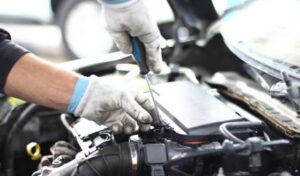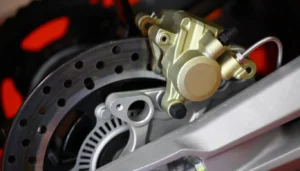If you notice that your motorcycle has a problem where it sputters, then it may not be easy for you to determine what the primary causes of this are. Because I know five different things that cause this problem, I have been able to solve it more than once.
If you want to avoid the trouble of having to deal with this problem, you must understand the five reasons why it happens.
When it comes to motorcycles, mechanical problems are unavoidable, especially if you have an older model.
What causes a motorcycle to sputter in particular?
The three elements that must be present for a motorcycle’s combustion chamber to produce more solutions are air, fuel, and a spark.
You may be certain that the sputtering problem will be discovered if you investigate the mechanisms that deal with these three components.
And I’m going to give you some examples of that in this article.
Why Is My Motorcycle Sputtering?
On a motorcycle, sputtering can be raised on by a number of different causes. It’s possible that the carburetor—specifically, a vacuum leak, a fuel leak, or tuning issues—is the cause of the issue.
It’s also possible that the ignition coil is faulty, the air filter is clogged, the engine timing is incorrect, or that the spark plugs or spark plug wires are rusty or broken.
1. Sputtering Due To Carburetor Issues
Carburetors have been a great mechanical product for older machines and usually do a pretty good job of providing the right air and fuel mixture the engine needs to power the motorcycle.
But they can get picky, which is why the switch was made to fuel injectors, and can cause problems with your motorcycle if some small part inside isn’t working right.
If you have a carbureted motorcycle that is sputtering, you’re likely having a problem with the carburetor.
Three main issues can be caused by the carburetor and make your motorcycle sputter.
The first is a vacuum leak, the second is a gas leak, and the third could be that the carburetor needs to be tuned.
Vacuum leaks can cause several problems with the functionality of a motorcycle, especially sputtering.
If there’s a vacuum leak, that means the carburetor isn’t giving the proper amount of air to the air and fuel mixture, which will ultimately result in sputtering and poor engine performance.
Vacuum leaks are usually prompted by cracked or brittle intake boots or because the clamp around them isn’t tight enough. This is found between the carburetor and the engine.
Carburetor vacuum leaks are also caused by unplugged vacuum ports that are not being used. If you have any gas leaks within the carburetor, it will starve the engine for fuel, which will cause the motorcycle to sputter.
Leaks within carburetors are usually caused by a brittle or cracked gasket that is just above the float bowl at the bottom of the carburetor.
You can usually tell if this is the culprit because you will easily notice the smell of gas and will be able to visually see any leaks that are happening in the area.
The third carburetor issue that can cause sputtering is that it simply needs to be tuned.
When a carburetor is out of adjustment, that means the air/fuel screw and the balance between the carburetors are out of sync.
2. Sputtering Due To Ignition Issues
If your carburetor is working fine or if you have a fuel injector, the next likely cause of sputtering is ignition issues.
Three possibilities could happen with ignition issues. The first is within the ignition coil; the second is the spark plug wires; and the third is the spark plug.
Check the spark plugs:
Take out your spark plugs and make sure there is no nasty buildup on them or any type of corrosion.
Also, make sure the point isn’t worn down and that the gap between the center and the ground electrode is the appropriate distance.
You can look online to see how big the gap should be for the spark plugs you have. You can find the tool to measure that at any auto store.
A malfunctioning spark plug will cause the cylinder it’s connected to to misfire, which will ultimately cause performance issues and cause the motorcycle to sputter.
Check the spark plug wires:
A common issue with older motorcycles is the part of the spark plug wire that connects to the spark plug; that connection head is sometimes threaded onto the spark plug wire.
Over time, that threaded connection becomes corroded and rusted.
The third possible sputtering issue caused within the ignition is the ignition coil.
It is possible for the ignition coil to not send enough spark to the spark plugs, which will again cause misfires within the engine.
In this case, the ignition coil is best diagnosed by a mechanic. Ignition coils have high voltage and are dangerous to handle if you don’t know exactly what you’re doing with them.
3. Sputtering Due To Clogged Air Filter
A clogged air filter on a motorcycle is another possible culprit for sputtering issues. If an air filter is dirty and clogged, the engine will not be able to get enough air into the air/fuel mixture it needs to properly power the motorcycle.
Air filters need to be changed out routinely, and people often forget to pay attention to them until they start giving them problems.
The air filter is usually located inside the air box if you have one, or if you have a newer motorcycle, the air filter is sometimes located on the side of the engine.
If you have pod filters, examine them to make sure there isn’t some sort of residue on them that’s preventing air from flowing through them.
4. Sputtering Due To Engine Timing Issues
A motorcycle can sputter due to timing issues. It’s unusual for the timing to start getting off by itself, and it’s usually caused by either someone rebuilding the engine and getting the timing off or someone previously attempting to fix the timing.
Off-timing of the engine could mean that the exhaust or intake valves are still slightly open during the combustion stroke of the four-stroke process, resulting in sputters and the motorcycle not running properly.
5. Sputtering Due To Fuel Injection Issue
Modern motorcycles now have fuel injection systems in place of carburetors. Because it is a more effective approach, it is gaining popularity every day.
Most frequently, a fuel filter or fuel pump will cause sputtering in a fuel injection system.
How To Fix Sputtering on A Motorcycle?
1. Dealing with the Carburetor Issue
Because carburetors are so delicate, the air/fuel mixture can be adjusted. This is done by carefully turning the air/fuel adjustment screw on the carburetor body. This will either add or reduce fuel in the mixture.
If you have more than one carburetor, it’s a good idea to change all the float bowl gaskets because they’re probably worn out too.
2. Remove or replace a clogged air filter
You can fix your sputtering problem and the bike’s performance right away by removing and replacing a clogged air filter. The fix is inexpensive and simple.
Try blowing compressed air all around the filter to get rid of dust and dirt if you need to travel a distance before changing the filter. This is only a short-term fix; you should change the air filter right away.
3. Solving Ignition System Problems
Make sure the bike is off before removing the rubber spark plug caps to examine your spark plugs. To inspect the insulator tips, gently remove the spark plugs using the proper size spark plug socket.
Replace the spark plugs with new ones if the sparblack is bent or the ceramic element is damaged.
It will also need to be replaced with new ones if the buildup on the spark plug insulator tip prevents it from producing the necessary amount of spark for combustion.
The color of the buildup on the insulator tips is one indicator of your air/fuel ratio.
You are running too much fuel if it appears black or like charcoal. You are running too lean if a white, chalky deposit is visible on the metal of the insulator tip.
This may be changed at the carburetor and will stop the bike’s sputtering ignition problems.
To fix the spark plug wires
If, upon inspection of the wire, you discover that it has been damaged in any way, then you will be required to replace it.
To fix the ignition coil
After determining that the issue is with the ignition coil, you will be required to replace the ignition coil in order to fix the problem.
4. Fixing the Timing Issues
The engine may have incorrect timing if, for example, the exhaust valve or the intake valve is left slightly open during the combustion stroke of the four-stroke process.
This results in sputters, and the motorcycle will not run in the correct manner.
Having a professional mechanic examine a motorcycle is your best bet for determining whether or not there is a problem with the bike’s timing.
If you are not an expert in the field, it is not recommended that you attempt to diagnose the problem on your own.
Repairs performed by inexperienced mechanics on the timing of a motorcycle are likely to result in additional problems.
The problem can be quickly identified by a mechanic, who in most cases will not charge very much for the diagnosis alone.
5. Fix Fuel Injection System Issue
In order to investigate the issue, you can carry out a test that is known as a fuel flow test.
If there is a problem with the ignition system, then you may correct it by evaluating the problem by doing this test on the fuel filter and the fuel pump. If there is a problem, then you can fix it.
Conclusion
I really hope you were able to figure out why your bike is lurching forward.
Fortunately, the majority of these issues, such as the carburetor and ignition issues, are relatively easy to diagnose and fix; however, the issues with the engine timing will require a significantly higher level of technical knowledge.
And having a mechanic take care of some of the problems on the inside of your vehicle for you isn’t such a bad idea, after all.






